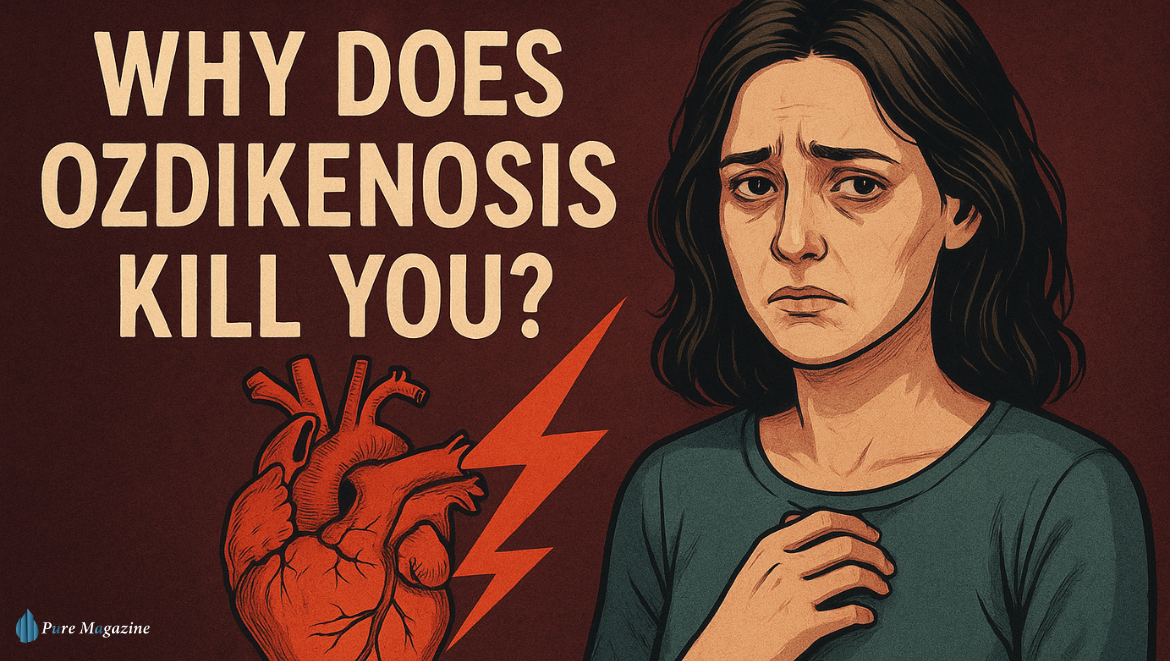Some words don’t mean a thing until they land in your life like a punch to the chest. Ozdikenosis is one of those words.
Most people will go their entire lives without hearing it. But for the few who do—patients, parents, partners—it’s not just a medical term. It’s a storm cloud that changes everything.
The question people whisper to doctors, or type into Google at 3 a.m., is haunting but simple:
“Why does Ozdikenosis kill you?”
The truth isn’t pretty: it’s because this disease doesn’t respect boundaries. It doesn’t hit one organ and stop. It spreads—slowly, relentlessly—until the systems you depend on to live can’t keep up anymore.
What Exactly Is Ozdikenosis?
Ozdikenosis is a rare genetic disorder. You don’t “catch” it like a cold—you’re born with it.
What makes it especially cruel is how quiet it can be. Some people carry it for years before the signs show. And by the time they do, damage is often already underway.
Here’s what makes Ozdikenosis so dangerous:
- It’s progressive. Once it starts, it doesn’t slow down on its own.
- It’s systemic. The disease doesn’t just stay in one area—it can damage the heart, lungs, kidneys, and more.
- It’s understudied. Compared to other illnesses, research is thin and treatments are limited.
That combination makes it a silent but deadly condition.
Early Signs Most People Miss
Ozdikenosis doesn’t kick down the door. It sneaks in. And because the early symptoms mimic common problems, it often gets brushed off.
Some of the subtle red flags include:
- Fatigue that doesn’t go away, even with sleep
- Losing weight without trying
- Getting sick often or taking much longer to bounce back
- Feeling winded during simple activities like climbing stairs
- Odd muscle pain, stiffness, or weakness
On their own, none of these scream “rare disease.” That’s exactly why Ozdikenosis is so dangerous—it hides in plain sight.
How the Disease Takes Over
The threat isn’t just in the symptoms. It’s in the way Ozdikenosis cascades through the body like dominoes falling.
It usually starts with the immune system misfiring. Instead of protecting the body, it creates constant inflammation. Over time, that wears down healthy tissue.
- The heart begins to beat irregularly.
- The lungs struggle to deliver enough oxygen.
- The liver shows abnormal enzymes and stops filtering toxins properly.
- The kidneys fail to keep the blood clean.
- And sometimes, the nervous system gets dragged in—causing brain fog, seizures, or clumsy coordination.
When several systems collapse at the same time, it leads to multi-organ failure. That’s the breaking point when medicine can’t hold the line anymore.
So, Why Does Ozdikenosis Kill You?
Because it pushes your body past the point of no return.
- Without lungs, oxygen doesn’t reach your cells.
- Without a strong heart, blood stops moving the way it should.
- Without kidneys and a liver, toxins poison the bloodstream.
- Without a functioning immune system, infections take over—or worse, the body attacks itself.
It’s not a single breakdown—it’s an all-systems crash. That’s why survival rates plummet once the disease progresses.
Who Faces the Highest Risk?
Since it’s genetic, Ozdikenosis isn’t something you can “cause” with lifestyle choices. But some factors can speed up the spiral:
- Family history (genetics loads the dice)
- Environmental triggers like toxins, stress, or infections
- Poor overall health (smoking, bad diet, unmanaged conditions)
- Late diagnosis, which leaves doctors with less room to help
Treatment: Managing, Not Curing
Here’s the hardest truth: there’s no cure yet. But that doesn’t mean nothing can be done. Treatment focuses on slowing progression and making life as manageable as possible.
- Supportive care: anti-inflammation meds, oxygen support, dialysis when kidneys fail.
- Research treatments: stem cells and gene therapy are being studied, with promising early results.
- Early intervention: spotting it sooner means more time to protect organs and improve quality of life.
For now, the goal isn’t a miracle—it’s time. More time with family, more time to live fully, more time for science to catch up.
The Human Side of Ozdikenosis
Doctors talk about lab values and scans, but patients live with much more than numbers. Ozdikenosis can mean:
- Mental health battles, like depression and anxiety
- Daily life changes, from diets and rest schedules to constant medical monitoring
- Tough family decisions, like whether to test children for genetic risks
- A deep need for community, because isolation makes the fight harder
One patient summed it up in a way no textbook could:
“It feels like my body runs out of energy faster than everyone else’s—and no one can plug me back in.”
Can It Be Prevented?
Not entirely—it’s genetic. But there are steps families can take:
- Genetic counseling before having kids
- Regular checkups if it runs in your family
- Stronger habits—healthy diet, exercise, stress control—so the body has more resilience against progression
Meanwhile, science is pushing forward. Biomarker research, gene editing, and stem cell therapies could rewrite the future for patients.
A cure isn’t here yet, but hope is no longer just wishful thinking.
FAQs
Q1. How long can you live with Ozdikenosis?
Life expectancy varies depending on how early it’s diagnosed and how quickly it progresses. With supportive care and close medical monitoring, some people live many years after symptoms begin. But if the disease advances to multi-organ failure, survival rates drop sharply. Early detection is the biggest factor in improving outcomes.
Q2. Is Ozdikenosis curable?
Right now, there’s no cure for Ozdikenosis. Treatments focus on slowing progression, protecting organs, and improving quality of life. Research into gene therapy and stem cell treatments shows promise, but they’re still in experimental stages.
Q3. What are the first warning signs of Ozdikenosis?
Common early symptoms include:
- Persistent fatigue that doesn’t improve with rest
- Unexplained weight loss
- Frequent illnesses or slow recovery from infections
- Shortness of breath during normal activities
- Muscle aches, stiffness, or weakness
Because these signs mimic other health issues, Ozdikenosis is often diagnosed late.
Q4. Who is most at risk for Ozdikenosis?
Since Ozdikenosis is a genetic condition, anyone with a family history is at higher risk. Environmental stressors—like toxin exposure, smoking, or unmanaged health conditions—can make symptoms worse, but they don’t cause the disease.
Q5. Can Ozdikenosis be prevented?
You can’t prevent the condition entirely because it’s genetic. However, genetic counseling, regular checkups, and healthier lifestyle choices (diet, exercise, stress management) can help reduce complications and prepare families who may pass the condition on.
Final Thoughts
So why does Ozdikenosis kill you? Because it slowly tears down the body’s defenses, system by system, until the organs you need most collapse together.
But awareness changes the story. Early detection, supportive treatment, and lifestyle strength can buy time—and time matters.
With rare diseases, knowledge isn’t just power. It’s survival.
Visit: Pure Magazine








